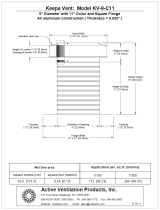Page is loading ...

OPERATOR'S MANUAL
1

Table of contents
Introduction ................................................................................................................. 3
System requirements .................................................................................................. 4
Operating the controls ........................................................................................... 4
Bitcrush ....................................................................................................................... 5
Chorus......................................................................................................................... 6
Comb Filter.................................................................................................................. 7
Compressor................................................................................................................. 8
Delay ........................................................................................................................... 9
Distortion ................................................................................................................... 10
Filter .......................................................................................................................... 11
Formant Filter............................................................................................................ 12
Frequency Shifter...................................................................................................... 13
Gain........................................................................................................................... 14
Gate .......................................................................................................................... 15
Haas.......................................................................................................................... 16
Ladder Filter .............................................................................................................. 17
Limiter ....................................................................................................................... 18
Phaser....................................................................................................................... 19
Pitch Shifter............................................................................................................... 20
Resonator.................................................................................................................. 21
Reverb....................................................................................................................... 22
Reverser.................................................................................................................... 23
Ring Mod................................................................................................................... 24
Stereo........................................................................................................................ 25
Tape Stop .................................................................................................................. 26
Trance Gate .............................................................................................................. 27
Acknowledgements ................................................................................................... 28
2

Introduction
Snapins are isolated audio effect modules, each performing a specific task. The
Kilohearts product lineup will allow you to combine these snapins in different ways in
order to create interesting and unique combinations of effects. Snapins can be loaded
into your DAW as a standard VST or Audio Unit plugin, as well as into other Kilohearts
plugins that can act as snapin hosts, for example Multipass.
3

System requirements
These are the minimum recommended system requirements for running snapins.
CPU
2 GHz or faster
Memory
1 GB or more
Operating System
Windows (7 or newer) or Mac OS X (10.7 or newer)
Software
A VST or Audio Unit compatible DAW
If you use a lot of snapins at the same time in your patch the CPU usage will
increase accordingly. Thus, we cannot guarantee that the snapins will work flawlessly
in all use cases even if your system does meet the minimum recommended system
requirements.
Operating the controls
Most parameters of the Snapins are controlled by the knobs and the sliders seen in
the UI. To move a knob or slider simply click on it, and while holding the mouse button
down move the mouse up or down.
Sometimes you might want more precise control when tuning a parameter. Hold the
shift key while moving a knob or slider to enter fine tuning mode, where the knob or
slider will move more slowly.
You can reset a knob to its default position by double clicking it.
Finally, most controls support entering the value using your keyboard by right-clicking
on them.
4

Bitcrush
The Bitcrush can be used to create distorting effects that
sound like that of scraping analog radio, or inherently lo-fi
sound sources, like old video games. It simulates the audio
being sampled and replayed using a low quality sampler with
limited sample rate and bit depth.
Rate
Down sample the signal to a minimum of 200 Hz.
Bits
Quantize the amplitude of each sample of the signal. A
lower value will result in a more distorted sound.
ADC Q
Quality of the analog-to-digital conversion. A lower value will add dissonant
aliasing in the low frequencies.
DAC Q
Quality of the digital-to-analog conversion. A lower value will add dissonant
aliasing in the high frequencies.
Dither
Adds noise to the signal in order to reduce distortion caused by quantization.
Mix
The dry/wet mix of this effect. A lower value will let some of the unmodified signal
through.
5

Chorus
The Chorus enhances the stereo effect and presence of a
sound by mixing it with delayed versions of itself.
Delay
The average delay for the delayed voices.
Rate
The frequency of how fast to vary the delay.
Depth
How much to vary the delay.
Spread
Stereo width of the effect. A lower value will go towards a mono output.
Mix
The dry/wet mix of this effect. A lower value will let some of the unmodified signal
through.
Taps
The number of chorus voices.
6

Comb Filter
The Comb Filter will mix the signal with a delayed version of
itself, creating a filter with repeated troughs and peaks
across the spectrum.
Cutoff
Cutoff setting for the filter, the distance between each
peak.
Mix
The dry/wet mix of this effect. A lower value will let some of the unmodified signal
through.
Polarity
The polarity setting swaps troughs for peaks and vice versa, with the plus setting
having a peak at 0 Hz, and the minus setting a trough at 0 Hz.
Stereo
The stereo setting flips the polarity setting for the right channel, allowing the the
comb filter to be used for mono compatible stereo widening.
7

Compressor
The Compressor will even out the audio volume by lowering
the volume when the signal is loud.
Attack
The attack time is the time it takes to lower the volume
when the input volume is over the threshold.
Release
The release time is the time it takes to return the volume
to normal when the input volume is under the threshold.
Mode
In RMS mode the compressor will measure the volume
using the root mean square method, which gives an
accurate measurement of audio power. In peak mode
the compressor will follow the peaks in the audio waveform, which makes it more
responsive to transients.
Ratio
The ratio decides how much the compressor will reduce the audio volume. At
1:2, for example, the volume will be lowered until it is halfway between the input
volume and the threshold.
Threshold
The threshold for when the compressor will start lowering the volume.
Makeup
The makeup gain will increase the volume of the output signal to compensate for
the loss in overall volume that the compressor causes.
VU Meter
Displays the current input level, the selected threshold, and the compressor's
current attenuation.
8

Delay
The Delay will delay the input signal for an echoing effect.
Delay
The amount of time beore the delayed sound starts
playing. This will be expressed in milliseconds or as
parts of a beat, depending on Sync Mode.
Sync Mode
When sync is enabled the delay time will be
synchronized to the song tempo.
Feedback
The feedback setting will cause the delayed sound to
feed back into the delay. This will create an exponentially decaying echo.
Pan
Adjust the panning of the delayed sound.
Ping-Pong
Swaps the left and the right channel of the delayed sound when it is fed back into
the delay. When combined with panning this will make the echo bounce back and
forth between the speakers.
Duck
When duck is turned up, the output volume from the delay will automatically be
lowered when the input volume is high.
Mix
The dry/wet mix of this effect. A lower value will let some of the unmodified signal
through.
9

Distortion
The Distortion is a versatile distortion effect with a wide
selection of algorithms.
Drive
The drive setting will boost the input signal, causing a
heavier distortion.
Bias
The bias will add a DC offset to the signal before
distorting. Adding some bias can prevent the distorted
audio from sounding hollow and uninteresting.
Spread
The spread will add different amount of bias to the left and right channels. This
can give some nice and subtle stereo widening.
Type
The flavor of distortion. Select between overdrive, saturate, foldback, sine and
hard clip.
Dynamics
A common problem with distortion is that it can remove the dynamic content of
the input signal, forcing the output to maximum volume. Turn up this knob to
preserve the dynamics of the input.
Mix
The dry/wet mix of this effect. A lower value will let some of the unmodified signal
through.
10

Filter
The Filter snapin provides a selection of common filters.
Type
The type of filter. Select between low pass, band pass,
high pass, notch, low shelf, peak and high shelf filters.
Cutoff
The operating frequency of the filter. In a low-pass filter
this is the frequency where the signal is reduced by 3dB.
Q
The filter Q setting. High values for Q will make the filter
resonate at the cutoff frequency.
Gain
The gain value for the low shelf, peak and high shelf filter types.
11

Formant Filter
The Formant Filter will boost two frequencies to mimic the
sounds of different vowels.
Vowel Selector
Selects two frequencies to boost.
Q
Adjust how powerful and narrow the frequency boost is.
Lows
Allow low frequencies through the filter.
Highs
Allow high frequencies through the filter.
12

Frequency Shifter
Frequency shifter will shift all the frequencies in the input
signal up or down by a certain amount. This kind of shifting
will ruin the harmonic content of the input signal, making it
sound dissonant.
Shift
How much to shift all frequencies by.
13

Gain
The gain snapin will increase or decrease the volume of a
signal.
Gain
Set how much to increase or decrease the volume, in
decibels.
VU Meter
Displays the current output level on the left and right channels.
14

Gate
The Gate will only let audio through when the input level is
above a set threshold.
Attack
The attack time is the time it takes to for the gate to fully
open when the input volume is over the threshold.
Hold
The hold time is the minimum time the gate will stay
open.
Release
The release time is the time it takes to for the gate to fully
close when the input volume is under the threshold.
Threshold
The volume threshold for when the gate will open.
Tolerance
A hysteresis range requiring the volume to drop a set amount of dB under the
threshold before closing.
Range
The amount to attenuate the signal when the gate is closed.
Look-ahead
When enabled, a 5ms look-ahead will be used, allowing transients through at the
cost of latency.
Flip
When flipped, the gate will act in reverse attenuating the signal when the gate is
open.
VU Meter
Displays the current input level, the selected threshold & tolerance, and the gate's
current state.
15

Haas
The HAAS effect will widen the stereo of the audio by
delaying the left or the right channel slightly.
Channel
Which channel to delay.
Delay
The delay time.
16

Ladder Filter
The Ladder Filter simulates low pass filters found in classic
hardware synths.
Cutoff
The filter cutoff frequency.
Resonance
The filter resonance setting. High values will make the
filter resonate at the cutoff frequency.
Topology
Selects between transistor ladder and diode ladder topology. The diode ladder
have a slightly more gentle rolloff after the cutoff frequency. The two topologies
also behave differently when saturation is enabled.
Saturate
Simulates saturation of electronic components in the filter.
Drive
Simulates overdrive of the components in saturate mode.
Bias
Simulates bias voltage over the components in saturate mode.
17

Limiter
The Limiter will prevent the audio volume from going over a
certain threshold.
In gain
Gain to apply to the input signal before limiting.
Out gain
Gain to apply to the input signal after limiting.
Threshold
The maximum allowed volume.
Release
The release adjust how quickly the limiter returns the volume back to normal after
limiting it due to a peak in the input volume.
VU Meter
Displays the current input level, the selected threshold, and the limiter's current
attenuation.
18

Phaser
The Phaser will filter the input signal, creating a series of
moving peaks and troughs in the audio spectrum.
Order
A higher order setting will increase the order of the filters
used by the phaser, creating a more pronounced effect
with more peaks and troughs.
Cutoff
Sets the cutoff of the filters in the phaser, moving the peaks and troughs in the
audio spectrum.
Depth
Adjusts the depth of modulation of the cutoff.
Rate
Adjusts the rate of modulation of the cutoff.
Spread
Adds a phase offset for the cutoff modulation between the left and right channels,
for a stereo widening effect.
Mix
The dry/wet mix of this effect. A lower value will let some of the unmodified signal
through.
19

Pitch Shifter
The Pitch Shifter will adjust the pitch of the input signal up or
down.
Pitch
How much to adjust the pitch, in semitones.
Jitter
How much randomness to add to the pitch. A high jitter
setting can give a unison-like effect.
Grain Size
During processing the pitch shifter chops up the audio into small snippets called
grains. This setting adjusts the length of the grains, which can influence the
sound.
Mix
The dry/wet mix of this effect. A lower value will let some of the unmodified signal
through.
20
/



